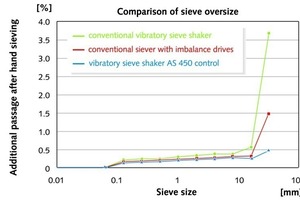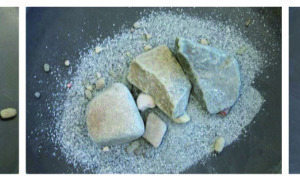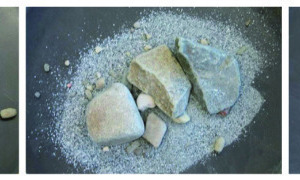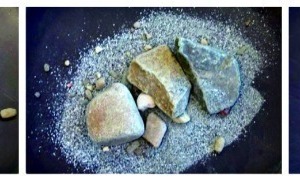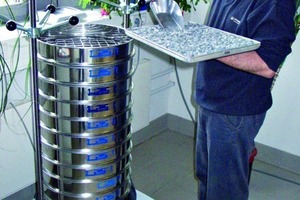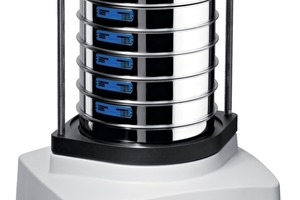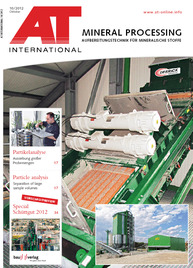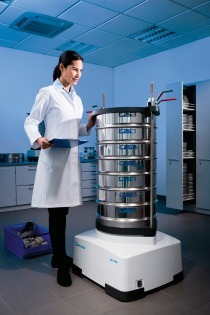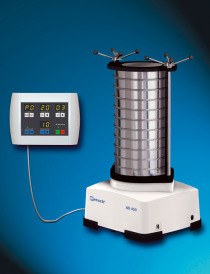Separation of large sample volumes with the AS 450 control
Particle analysis of large quantities of bulk goods is usually done by vibratory sieving. In most vibratory sieve shakers in the market the sieve stack is mounted on springs which oscillate vertically. However, to evenly distribute the material over the entire sieve surface, the so called 3D vibratory sieving as it is used in the AS 450 control is the most suitable method (Fig. 1). This is characterized by a circular motion superimposing the vertical throwing motion so that the sample material is moved over the whole sieve.
Larger particles need high acceleration to rotate freely and then fall back statistically oriented. Therefore, a high amplitude is essential when the sieve stack carries heavy loads. Regardless of the load, the AS 450 control always generates amplitudes of up to 2.2 mm whereas other sieve shakers with electromagnetic drives only achieve 2 mm and, if the load increases, even substantially less. Sieve shakers with imbalance drives have long been considered as the most powerful systems in the market but have the great disadvantage of an uncontrolled drive. As a consequence, the energy input varies greatly depending on the load.
With high loads the generated amplitude is so low that neither a complete separation nor reproducibility of the results are ensured. RETSCH has now combined the benefits of electromagnetic sieving – controlled amplitude with highest reproducibility – with the powerful drive based on the CET technology (Continuous Energy Transformation). The result is a sieve shaker that achieves such high separation efficiency - regardless of the load - so that manual re-sieving becomes obsolete.
Figures 2 to 4 show the oversize obtained by manual re-sieving after separating identical samples with vibratory sieve shakers of different manufacturers. The graphic (Fig. 1) clearly shows that the conventional sieve shaker with electromagnetic drive (based on pulse width modulation principle) provides the worst results (> 3.5 % oversize). The sieve shaker with imbalance drives also shows a high percentage of oversize (approx. 1.5 %) whereas the AS 450 control provides the best results with < 0.5 %. This makes the AS 450 the only sieve shaker which meets the requirements of many standards (e.g. EN 933-1) for a sieve oversize of not more than 1 % without manual re-sieving.
The Geological Office in Mainz/Germany supervises the exploitation of gravel, sand, split and rubble whereas the Mining Office evaluates filling materials. Both fields require sampling and analysis of these products in their own loose rock laboratory which is part of the central geotechnical laboratory. Since November 2009, this has been the workplace of the AS 450 control (Fig. 5).
Ingo Schultheis, head of the geotechnical laboratory, expects high quality standards of the laboratory equipment he uses: “The accuracy of the sieving procedure, starting with sample division and ending with the particle size distribution curve, is a big issue for us. We are the highest supervisory body so we have to fulfil all relevant quality standards. That means we need measurement results which are exactly reproducible.”
The geotechnical lab analyzes many different samples. “The application field for the AS 450 control is very varied”, explains Schultheis. “It is used for round shaped sand of 0- 2 mm as well as for broken rail track rubble from 0- 70 mm, with and without interval mode.” Schultheis and his team have found out that the separation efficiency is particularly high when using the interval mode so that no manual re-sieving is required. Another advantage appreciated by Schultheis is the stability of the AS 450: “The oscillations of our former sieve shaker were not transferred to the sieve stack but to the floor which lead to problems with other tests, such as sedimentation analyses. The oscillation transfer of the AS 450 to the floor is so low that other tests are not affected in any way.”

